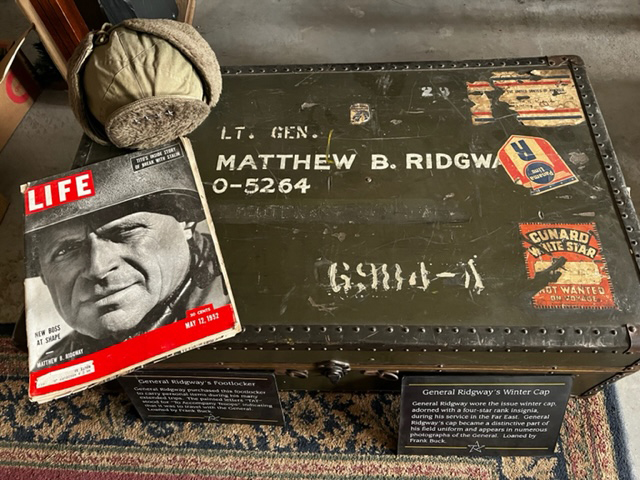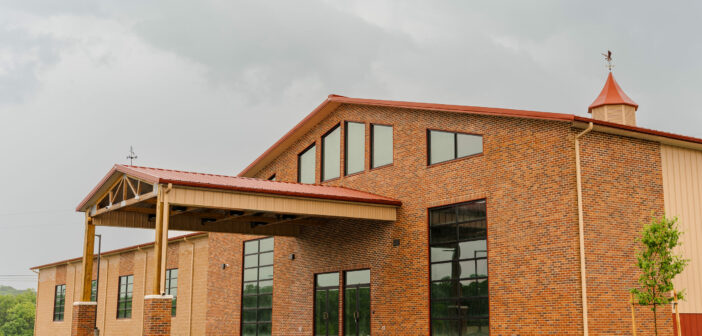At the New World War II Museum in Gettysburg
By Jessica James | Opening photo by Emily Staley
Gettysburg, known far and wide as a “bucket list” destination for Civil War enthusiasts, is home to a new museum that features a different—but no less monumental—era in American history.
The World War II American Experience and Education Center is a tribute to the valor, values, hard work, and unity of the nation during the war.
Opened in June at 845 Crooked Creek Road, the museum was founded by Gettysburg residents Frank and Loni Buck as a way to educate the public and share their family’s passion for World War II vehicles and memorabilia. The 36,000-square-foot facility is designed to provide an educational experience that is both meaningful and lasting by giving visitors the full contextual story of the United States’ involvement in World War II.



Before the museum opened, the Bucks had welcomed thousands of visitors to their Gettysburg farm, making it a gathering place for veterans’ groups, historic automobile clubs, and military associations. Their collection of vehicles, period attire, and original artifacts has also been used in the filming of movie footage and television documentaries.
Bringing History To Life
Although the idea for the museum started as a way to share the Buck family’s vast collection of period artifacts with the general public, the scope of the endeavor has expanded to include much more.
The name “American Experience” indicates that this isn’t a museum where visitors walk through a display of historical objects reading placards. This is a place to “experience” every aspect of the 1940s.
“We want guests to get a true feel for what life was like—both at home and on the battlefield,” Loni Buck says.
In addition to preserving the artifacts and stories of those who played a role in World War II, the museum helps educate the public about the sacrifices made by Americans both on the battlefield and the homefront.
The museum also aims to honor and demonstrate the united effort of Americans from every walk of life who helped preserve freedom by stepping up to help win the war.
From the soldiers, sailors, airmen, merchant marines, doctors, and nurses to those who labored in the factories, built airplanes, or volunteered as civil defense workers, the stories of those who fulfilled their civic duty are told.
Interactive displays, simulated and real vehicle experiences, living history programs, and live demonstrations combine to give visitors a true sense of time and place.
The museum also tells the story of the U.S. involvement in World War II through the eyes, experiences, and memories of the people of Gettysburg, Adams County, and the surrounding region through artifacts and recorded video interviews.
From The Battlefield
Walking through the museum is like walking into the pages of a history book. A variety of military vehicles and equipment have been preserved and will be used for historic and educational purposes to teach future generations about the impact of the war.
In addition to the collection of tanks, vehicles, uniforms, helmets, and memorabilia, guests will be able to see—and in some cases, ride—in vintage vehicles.
“These are the vehicles that won the war,” Loni Buck says of the massive historical collection. “Everything here has a story behind it.”
The wide variety of vehicles on display ranges from a Jeep still in a crate to a Jeep painted with bright yellow and black checkers. This “Follow Me” Jeep was painted in bright colors so it could be seen by pilots to guide them down the taxiway to the location it was to be parked.
But the massive Sherman tanks are the vehicles that get the most attention from visitors. One of the tanks in the museum has two signatures on its side from Pennsylvania World War II veterans who are very familiar with the combat vehicle.
Walter Stitt, a Battle of the Bulge veteran, was a loader for a Sherman tank crew in the 3rd Armored Division. He arrived at Omaha Beach in Normandy several weeks after D-Day and was part of the effort to push through France and Belgium and into Germany.
On three separate occasions, Stitt’s unit was struck by a German tank shell that killed other members of the crew. The first time it happened, Stitt was the only survivor and said he was reaching down for a shell when the tank was hit, which probably saved his life.
The other signature is Clarence Smoyer, a tank gunner, who served in the famous “Spearhead Division” of the U.S. Army’s 3rd Armored Division. He was credited for destroying a German tank in the Battle of Cologne near the town’s famous cathedral in March 1945 and took out four additional German tanks during two years of service.
Other vehicles that aren’t as familiar, but still played significant roles in the war, include a GMC CCKW general purpose shop truck, tank destroyers and tank recovery vehicles, and a Red Cross Clubmobile.
Clubmobiles played a vital part in the war effort by providing homelike comforts to troops in the field. Three Red Cross volunteers in each vehicle served coffee and donuts to the troops and distributed cigarettes, Life Savers, and gum. Some of the Clubmobiles played music over loudspeakers as well.
But the role these “Donut Dollies” played is more significant than just giving American soldiers a taste of home. They followed the troops on the battlefield, faced grave danger themselves, and contributed significantly to keeping up the morale of the GIs.
On The Homefront
Although the museum has no shortage of authentic World War II military vehicles, uniforms, helmets, and other battlefield artifacts, it also devotes space to interpret life back in the states.Citizens played a significant role in bolstering the war effort including forming local aircraft warning services and “scrapping for victory.” The American Experience demonstrates how the country stood united in its willingness to lend a helping hand.
Even children took part in the war effort by not only gathering scrap metal, but by picking milkweed, which was used for buoyancy in life vests. During the last two years of World War II, 25 million pounds of milkweed pods were picked by volunteers in 25 states—including Pennsylvania.
The government paid pickers 20 cents a bag for milkweed floss, which is five or six times more buoyant than cork. It is also warmer and six times lighter than wool. This united effort created 1.2 million life preservers, saving sailors’ lives at a cost of 75 cents a pound.
Another interesting “experience” includes walking through a fully constructed 1938 “Sears house” decorated the way it would have been during the war years. When visitors step outside, they’ll find an all-original 1931 Model A Ford, the type of car the average family owned at the time.
Other displays include original “Scrap Drive” posters as well as information about victory gardens, rationing, and U.S. bond drives.
The museum displays an EarthBox by the main entrance to raise awareness of their plans to install their own Victory and Legacy gardens.
History And More
Special programming at the museum includes re-enactments, living history programs, speakers, seminars, and interactive offerings. The museum will also have special rotating exhibits, USO-style programs, swing dances, and live music from the 40s.
Guided group tours can be arranged as a way for schools, camps, service organizations, and large families to experience the American sacrifices made during the world’s largest conflict of the 20th century.
The museum has an on-site cafe, set up like a British pub, that serves sandwiches, snacks, and beverages. The facility’s gift shop sells a variety of unique items, including handmade quilts, wooden toys for children, war memorabilia, and even special Christmas ornaments.
Additionally, the museum has a large conference room, a temperature and humidity controlled archive room, and an area that can be opened up for larger special events.
Why Gettysburg?
Gettysburg is an ideal location for this World War II museum because of its natural draw as a place of remembrance for veterans. In fact, of the roughly 7,000 graves at the Gettysburg National Cemetery, more than 1,600 are World War II veterans, and around 500 of them were killed in battle.
Additionally, a Prisoner of War (POW) camp for German prisoners was established at the Gettysburg National Military Park in 1944. POW labor was used in the growing, harvesting, and processing of local agricultural products.
But, perhaps most importantly, Gettysburg is considered a symbol of sacrifice and continues to be a top destination for patriotic Americans who honor the past and want to learn from history.
To learn more about the WWII American Experience Museum and Education Center, visit www.visitWW2.org.




